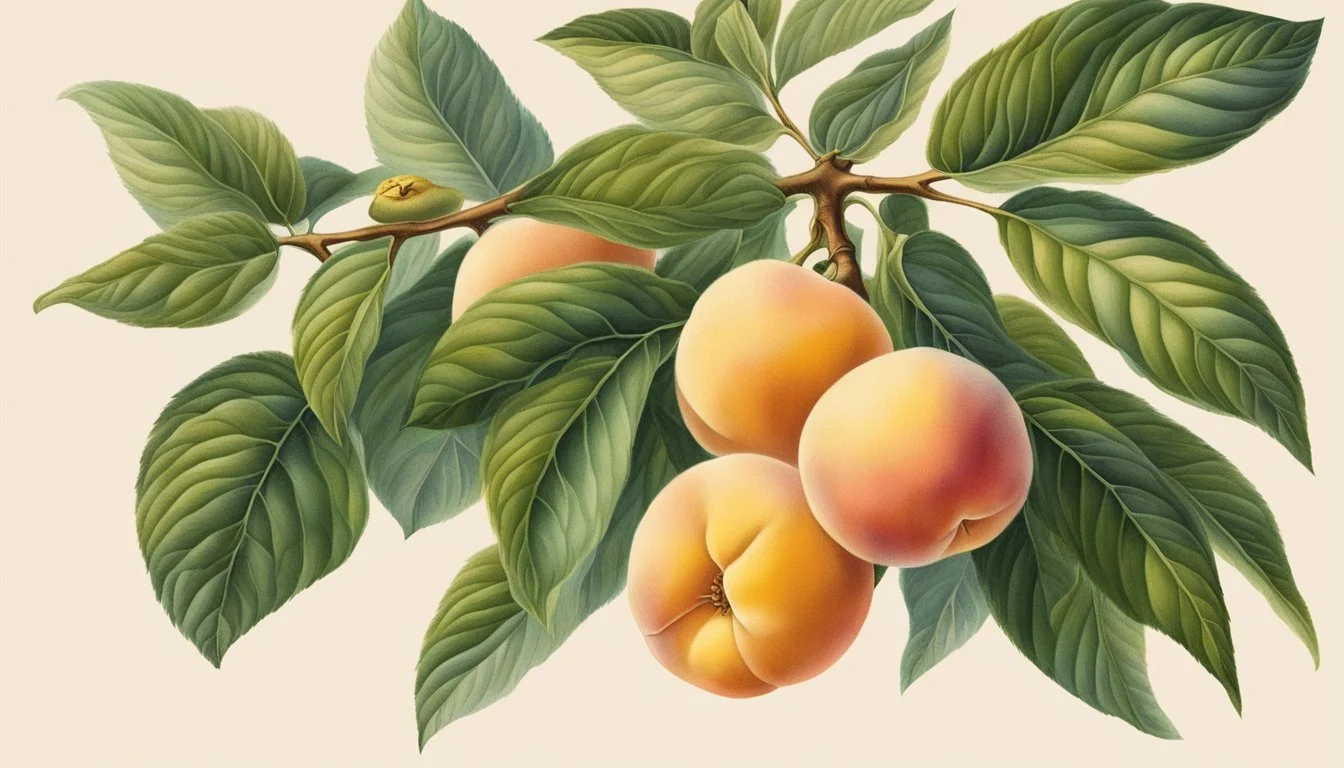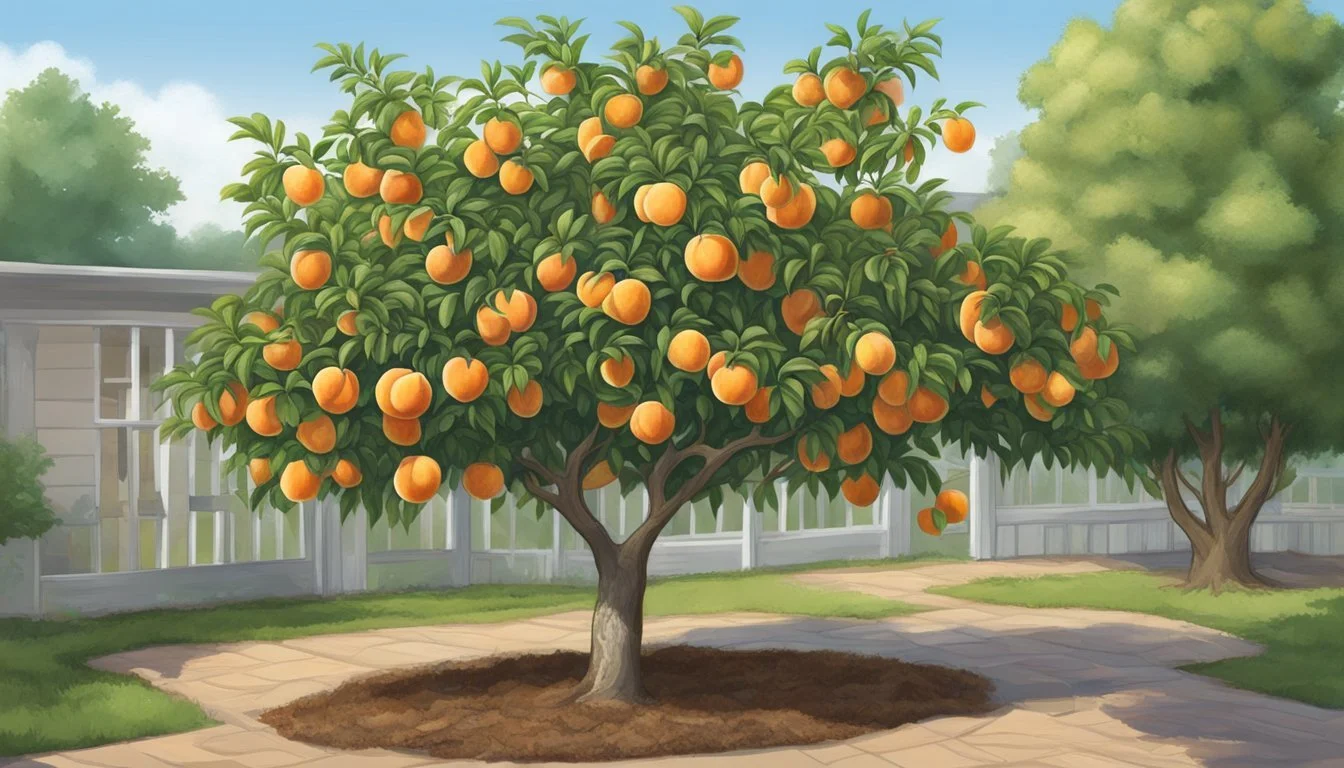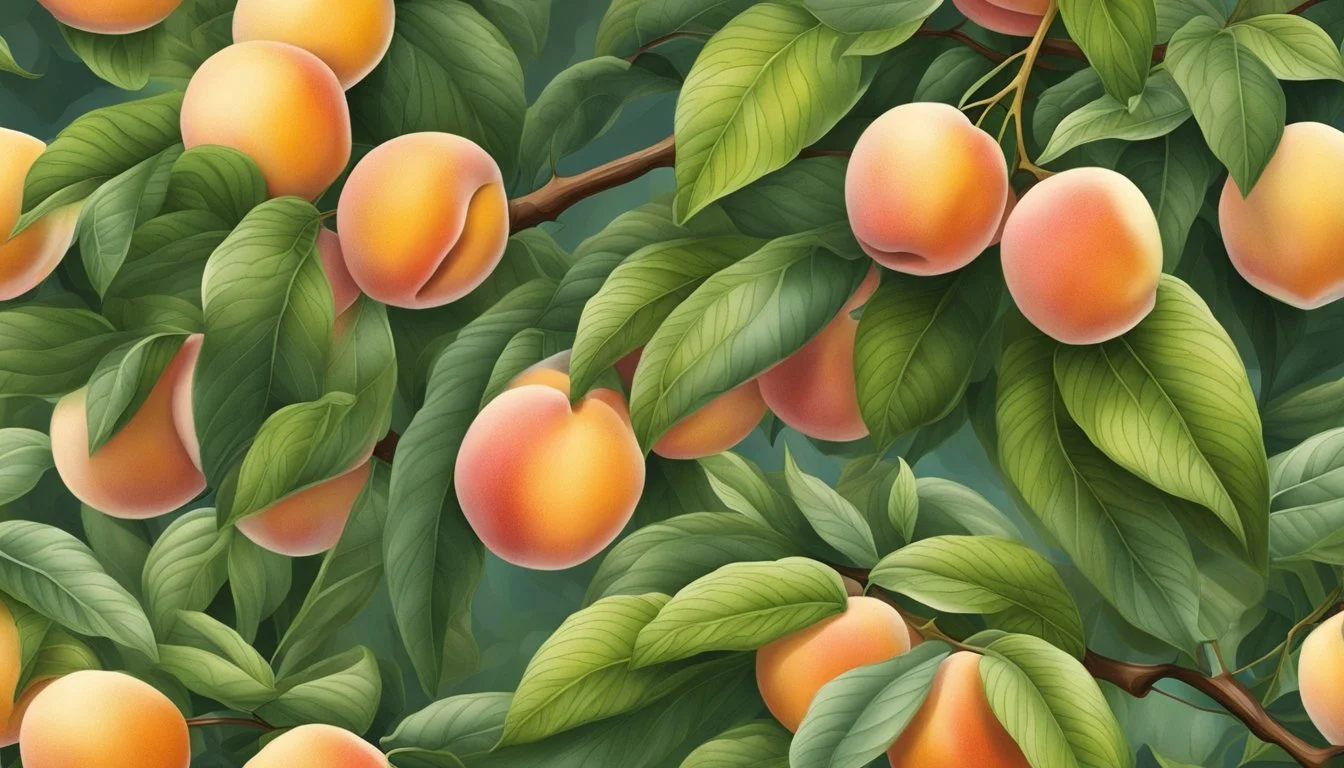How to Tell If Belle of Georgia Peaches Are Ripe
Your Expert Ripeness Checklist
Determining the ripeness of Belle of Georgia peaches is essential for anyone looking to enjoy the succulent sweetness of this prized fruit. Recognizable by their large size and appealing red over a creamy white background, these peaches are a favorite among home gardeners and commercial producers alike. Correctly identifying when these peaches are ready to pick ensures the best possible flavor, texture, and nutritional value, making it a worthwhile skill to master.
Understanding the subtle signs of ripeness goes beyond the basics of color changes—although a good indicator, it's not the only factor to consider. Factors such as fruit firmness, aroma, and even the ease with which the peach detaches from the branch are all crucial cues. For those cultivating their own trees, knowledge of proper care, pest management, and harvesting techniques all contribute to the overall success of the yield and the quality of the fruit.
Key Takeaways
Belle of Georgia peaches are ripe when they show color changes, have a sweet aroma, and detach easily.
Proper tree care and pest management ensure the health of the peach trees and the quality of the fruit.
Utilizing correct harvesting techniques maximizes the flavor and extends the shelf life of Belle of Georgia peaches.
Identifying Ripe Belle of Georgia Peaches
To determine the ripeness of Belle of Georgia peaches, one needs to assess specific indicators such as coloration, tactile feedback, and aroma. These cues are definitive in distinguishing ripe peaches from those that need more time to mature.
Color and Appearance
A Belle of Georgia peach that is ready to be eaten exhibits a yellowish-orange background color, which can be assessed by looking at the skin around the stem, as it is shielded from direct sunlight. Ripe peaches also have a characteristic red blush. An unripe peach, in contrast, may show a greenish-white color, indicating immaturity.
Unripe Peach: Greenish-white color
Ripe Peach: Yellowish-orange with red blush
Texture and Firmness
The texture of a peach is a significant indicator of its ripeness. A ripe Belle of Georgia peach will yield slightly to gentle pressure, feeling soft but not overly mushy. One should handle the fruit carefully to avoid bruising. Peaches that are firm or very hard require more time to reach the optimum level of ripeness.
Unripe Peach: Firm to hard
Ripe Peach: Soft with slight give
Aroma and Smell
The smell of a peach can be a telltale sign of its ripeness. Belle of Georgia peaches that are ripe emit a sweet and floral aroma that is noticeable upon close inspection. This scent becomes more pronounced as the fruit reaches peak ripeness. If there is little to no smell, the peach likely needs more time to develop its full aromatic bouquet.
Unripe Peach: Little to no smell
Ripe Peach: Sweet and floral aroma
Best Practices for Peach Tree Care
Cultivating Belle of Georgia peaches requires a dedicated approach to tree care. Ensuring the health and productivity of peach trees involves managing water, soil conditions, and growth with precision.
Watering and Moisture Retention
Peach trees need consistent moisture, especially during fruit development in spring and summer. Young trees typically require weekly watering, while established trees benefit from deep watering every two weeks. The goal is to provide enough water to moisten the soil to a depth of 6-8 inches. Rainfall must be supplemented with irrigation during dry periods. Mulching around the base can help retain soil moisture and regulate temperature.
Frequency: Weekly for young trees; bi-weekly for established trees
Depth: 6-8 inches of soil moisture
Mulch: Apply around the tree base
Soil and Fertilization
For optimal growth, Belle of Georgia peach trees need well-drained soil enriched with organic matter. The ideal soil pH is between 6.0 and 7.0. Fertilization should commence in early spring before new growth emerges. Typically, a fertilizer rich in nitrogen is recommended. As the tree matures, a balanced 10-10-10 formula can be applied annually. Fertilizers should not be applied later in the growing season to prevent new, tender growth from emerging which can be damaged by frost.
Soil Type: Loamy to sandy, well-drained soil
pH Level: 6.0-7.0
Fertilizer: High-nitrogen or balanced 10-10-10 formula
Pruning and Managing Growth
Pruning is essential for maintaining a strong tree structure, promoting air circulation, and managing disease and insect pressures. Prune peach trees in late winter to remove dead or diseased branches and to open up the tree's canopy. This directs energy to healthy growth and fruit production. Thinning out the fruit can reduce the burden on branches and increase the size and quality of the peaches. Remove any suckers or water sprouts to prevent them from drawing energy away from the fruit-bearing parts of the tree.
Timing: Late winter for pruning; spring to thin fruit
Focus: Remove dead branches, open canopy for air circulation
Maintenance: Remove suckers and water sprouts regularly
Harvesting Techniques
When harvesting Belle of Georgia peaches, the grower's precision in timing, picking technique, and post-harvest handling is essential to maximize fruit quality and longevity.
Determining Harvest Time
The optimal period for harvesting Belle of Georgia peaches typically falls in early August, when the fruits achieve peak ripeness. Signs of readiness include a background color change from green to yellow and a slight give to the fruit when gently pressed. It’s critical to monitor the peaches daily as the harvest time approaches to ensure they are picked at their peak.
How to Pick a Peach
To properly pick a peach, one should cradle the fruit in the hand and twist it slightly. If the peach is ripe, it will detach from the stem with ease. Avoid pulling the fruit straight away from the branch to prevent damage to both the peach and the tree.
Step 1: Hold the peach firmly but gently.
Step 2: Twist the fruit slightly.
Step 3: If the peach detaches with little resistance, it is ready to be harvested.
Post-Harvest Handling
After harvest, Belle of Georgia peaches must be handled with care to maintain their quality. They should be placed in a single layer in a shaded, cool place to prevent bruising and to prolong shelf life. If refrigeration is used, it should be at a temperature that does not cause cold injury to the delicate fruit.
Immediate Handling: Avoid stacking peaches to minimize bruising.
Cooling: Store at temperatures just above freezing.
Hygiene: Ensure cleanliness in all handling to reduce the risk of spoilage.
Understanding Peach Growth Cycles
The growth cycle of the Belle of Georgia peach is dictated by seasonal changes and environmental conditions, influencing everything from flowering to fruit maturity. An understanding of these cycles is crucial for effective cultivation and timely harvest.
From Flower to Fruit
Belle of Georgia peach trees enter their flowering stage in early spring as temperatures rise above freezing. Once pollinated, flowers develop into fruit, which grows and matures through the summer months. Full sun and proper temperature regulation are vital during this transformative phase, ensuring optimal fruit development.
Early Spring: Bloom initiation and pollination.
Summer: Fruit set and growth.
Seasonal Care Schedule
Throughout the year, attention to a care schedule ensures healthy growth and fruit production. In spring, fertilization supports flower and fruit formation. Summer requires consistent watering, ideally through a well-draining system, to maintain fruit growth. By fall, preparation for dormancy begins with reduced watering and pruning. Come winter, the trees are dormant, a seasonal rest essential for the next cycle of growth.
Annual Care Timeline:
Spring: Fertilize for fruit development.
Summer: Regular watering for fruit growth.
Fall: Prepare for dormancy, reduce watering, and prune as necessary.
Winter: Period of dormancy.
Climate and Environment Adaptation
Belle of Georgia peaches flourish in USDA zones 5 through 8, requiring specific conditions such as chill hours and sun exposure to thrive. These peaches need full sun, at least 6 to 8 hours a day, and are heat-tolerant, although they fare best with moderate temperatures. Trees must be spaced appropriately—standard trees 20 feet apart and dwarf varieties 10 feet apart—for adequate sunlight and air circulation.
Environmental Requirements:
Sunlight: 6-8 hours of full sun daily.
Chill Hours: Adequate cold exposure during dormancy.
Spacing: Ample space for light and airflow.
Drainage: Well-drained soil to avoid waterlogging.
Peach Tree Planting Guide
Planting Belle of Georgia peach trees requires careful consideration of location, planting techniques, and variety selection to ensure healthy growth and abundant crops.
Choosing the Right Location
For Belle of Georgia peach trees, gardeners must select a site with full sun exposure, meaning the trees should receive at least 6-8 hours of direct sunlight daily. The chosen location should offer well-draining soil to prevent root rot and other water-logged conditions that can adversely affect the trees. Assessing the soil's pH, which should ideally be between 6.0 and 7.0, is also integral for the successful establishment and growth of these fruit trees.
Planting Technique and Steps
Planting should occur in late winter or early spring, to allow the tree to establish before the growing season. To plant a Belle of Georgia peach tree:
Dig a hole that is twice as wide as the root ball and approximately as deep.
Inspect the rootstock before planting, removing any damaged roots.
Place the tree in the hole, ensuring that it's level with the ground.
Backfill the hole halfway with soil, settling it around the roots to remove air pockets.
Water the planting area thoroughly to help the soil settle.
Finish backfilling the hole, again ensuring no air pockets are trapped.
Manage irrigation to maintain consistent moisture without causing excessive saturation.
Selecting Suitable Varieties
When choosing Belle of Georgia peach trees for a backyard orchard, consider the variety's compatibility with the local climate and soil. This particular variety is known for its large, sweet fruit and is a self-pollinating cultivar, which means it does not require another tree for pollination. However, introducing other varieties of peaches can encourage better pollination and potentially yield larger crops. Selecting a healthy plant that is well-suited to the region's climate will be fundamental in establishing a productive orchard.
Nutritional and Culinary Aspects of Belle of Georgia Peaches
Belle of Georgia peaches are known for their large size, juicy texture, and sweet flavor, making them not only a delicious choice for a variety of dishes but also a nutritious fruit option. They offer a combination of health benefits and can be used in an array of culinary applications due to their rich sweetness and versatility.
Health Benefits
Belle of Georgia peaches are a nutritious addition to any diet, offering a range of vitamins and minerals. Here is a brief overview of the nutritional value they provide:
Vitamin A: Essential for eye health and immune function.
Vitamin C: An antioxidant that helps with skin health and immune support.
Fiber: Aids in digestion and can help regulate blood sugar levels.
Potassium: Important for maintaining electrolyte balance and proper heart function.
These peaches can be an integral part of a balanced diet, assisting in overall health and wellness.
Cooking and Preparation Tips
When it comes to incorporating Belle of Georgia peaches into meals, their sweetness and juicy flesh make them ideal for both sweet and savory dishes. Here are some tips to get the most out of their culinary potential:
Raw Consumption: Simply wash and enjoy the peach in its natural state to savor its freshness.
Baking and Desserts: Slice or cube peaches for pies, cobblers, and other baked goods to highlight their natural sweetness.
Grilling: Halve and pit peaches, then grill for a charred, caramelized flavor perfect for summer barbecues.
One should always select peaches that give slightly to pressure and have a sweet fragrance to ensure peak ripeness for any culinary use.
Common Pests and Diseases
When cultivating Belle of Georgia peaches, growers must be vigilant in monitoring for pests and diseases that can impact the health of the trees and the quality of fruit. This section provides an introduction to identifying common threats and outlines the necessary prevention and treatment strategies.
Identification of Pests and Diseases
Pests:
Oriental Fruit Moth: Larvae bore into fruit and shoots, causing direct damage.
Peachtree Borer: Evidence of this pest includes gumming and frass at the base of the tree.
Diseases:
Brown Rot: Indicated by brown, soft spots on fruit and blossom blight.
Peach Leaf Curl: Causes leaves to pucker and twist, with a red discoloration.
Prevention and Treatment
Sanitation: Regularly remove and destroy fallen fruit and prune affected branches to reduce pest incidence.
Chemical Controls: Use insecticides judiciously. Timing of application is critical for effectiveness.
Disease Control:
Cultural Practices: Plant in well-drained soil and provide adequate air circulation through pruning.
Fungicides: Apply fungicides as a protective measure during early spring or as directed by local agricultural extension services.
Frequently Asked Questions
In this section, you'll find detailed answers to common queries about the age and longevity of your Belle of Georgia peach trees and the various factors that can influence their growth and fruit production.
Age and Longevity of Peach Trees
To understand how long a peach tree can bear fruit, one must consider its lifespan and maturity. Belle of Georgia peach trees, on average, can live for about 15 to 20 years. However, they typically start bearing fruit within 3 to 4 years of planting. The tree's age is crucial for planning your backyard orchard, as is leaving adequate spacing of 20 feet between standard peach trees for optimal growth and sunlight exposure.
Factors Affecting Peach Tree Growth
Several factors can impact the health and yield of peach trees. Full sun is paramount for their thriving, requiring at least 6-8 hours of direct sunlight daily. The climate also plays a significant role in their growth; peach trees prefer temperate zones. When discussing the factors contributing to the tree's growth, it is important to emphasize the need for well-draining, loamy soil—rich in organic matter with a pH between 6.0 and 6.5—to prevent root diseases. Spacing and the incorporation of a backyard orchard layout further affect the tree's growth, as sufficient room allows for better air circulation and reduces disease transmission between trees.







